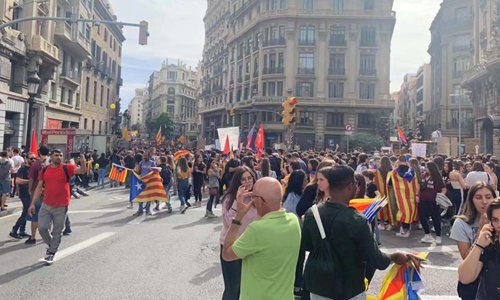HOME >> OPINION
Weak governance fuels violence in Catalonia
Source:Cristina Font Published: 2019/10/19 17:09:28

Photo: Global Times
All the international mainstream media have Catalonia on their front pages again. While the new Catalan riots might have taken foreigners by surprise, but in Spain, we had anticipated this for months.
The fourth general strike in less than two years stirred Catalonia this Friday. Like the others, this strike is linked to the independence movement and has been organized by pro-independent unions. At the beginning of the week, the Supreme Court sentenced several pro-independence political leaders to imprisonment on charges of sedition and embezzlement of public funds. After the verdict was made public, Catalans were called to use their right to civil disobedience and, consequently, riots have started.
Through a virtual platform known as the 'Democratic Tsunami', the mass agitations are being organized. Tsunami convened on October 14 and rallied a protest of more than 8,000 people at the airport. Following that, every night, peaceful manifestations have been interrupted by acts of violence. Besides the Tsunami Platform, there's another important player, the Committee for the Republic's Defense (CDR, in Catalan). It's a joint forum of various social associations.
Both Tsunami and CDR are among the main instigators of civil disobedience, though Catalan political factors are also partly responsible for this. However, even though they have publicly declared that "independence" is achievable through the institutions and streets, it does not mean violence is welcomed. It has been condemned by all political actors in Catalonia and Madrid. As members of the Catalan government said, "Catalan people may have a claiming character, but they are also pacifist".
Hence, who is provoking the violent disturbance? The police force has detected anarchist, ultra-nationalist, and anti-government groups among the CDR. Those groups from outside Barcelona, the Catalan capital, are ready to unleash the chaos in the capital, including other major cities. This Friday, on the backdrop of the general strike, the so-called "freedom march" set a perfect stage to perpetuate their violence.
According to the Home Office, radical demonstrators use different apps with the QR system, and other social media like Telegram to organize themselves. Madrid has acknowledged that even though those groups represent a minority, their strategies have a strong impact on the events of the week.
Security experts are concerned that from Friday through the weekend, there might be an escalation of violence, and Barcelona has become their playground for "urban guerilla" tactics. In this way, the radical young people with their hoodies on are facing the security forces as they burned containers and urban furniture, set barricades, and hurled acid and Molotov cocktails.
Catalan riots are reportedly taking a lesson from Hong Kong ones. Certainly, Madrid and Beijing are facing deep-rooted historical conflicts, and an easy solution may not be in their near future.
There are some similarities between the Hong Kong riots and the Catalan ones but only on the surface. Five years ago, the young rebels' movement in Hong Kong was relatively peaceful. That year, the umbrella revolt lasted 79 days. But, five years later, that young generation has grown up and this time, their strategy is more sophisticated and violent. In order not to tire out the population, the rallies are short, and mainly on the weekends. Secondly, there are no visible leaders who can be caught. Thirdly, there is an efficient use of technology for organizing demonstrators and building strategies. Finally, when it is necessary, they are willing to use violence.
Besides, the situation in Spain should be observed, metaphorically speaking, like an iceberg. On the top, we see the direct conflict. On the second level, there's an important social fracture in Catalonia. On the next level, the Catalan political arena interferes with the State's government. Lastly, during the last couple of years the Spanish government has been unstable, new elections scheduled for the second time this November speak volumes about that. For that reason, state political parties are using the Catalan conflict for their benefit, which further destabilizes and increases the social fracture among Catalan society and the other Catalan regions. Although the background is different, the Catalan and Hong Kong protests certainly have strategic and tactical similarities. First, the use of technology and social media has given protesters in both the unrest spots an enabling environment. The new tools are helping Hong Kong protesters unlike more than five years ago.
Second, governance is facing challenges in more places. The unrest may worsen into another Arab Spring-like situation with dissatisfied citizens revolting against economic and political institutions. In the last few years, the world has overcome financial and economic crises, refugee controversy, trade wars and significant changes in political institutions. In this context, if people's lives do not improve, there is a danger of civil disobedience growing and spreading further, perhaps even to places that have never experienced it before.
The author is a Spain-based foreign policy analyst. Follow her on twitter @cfontharo. opinion@globaltimes.com.cn
RELATED ARTICLES:
Posted in: VIEWPOINT